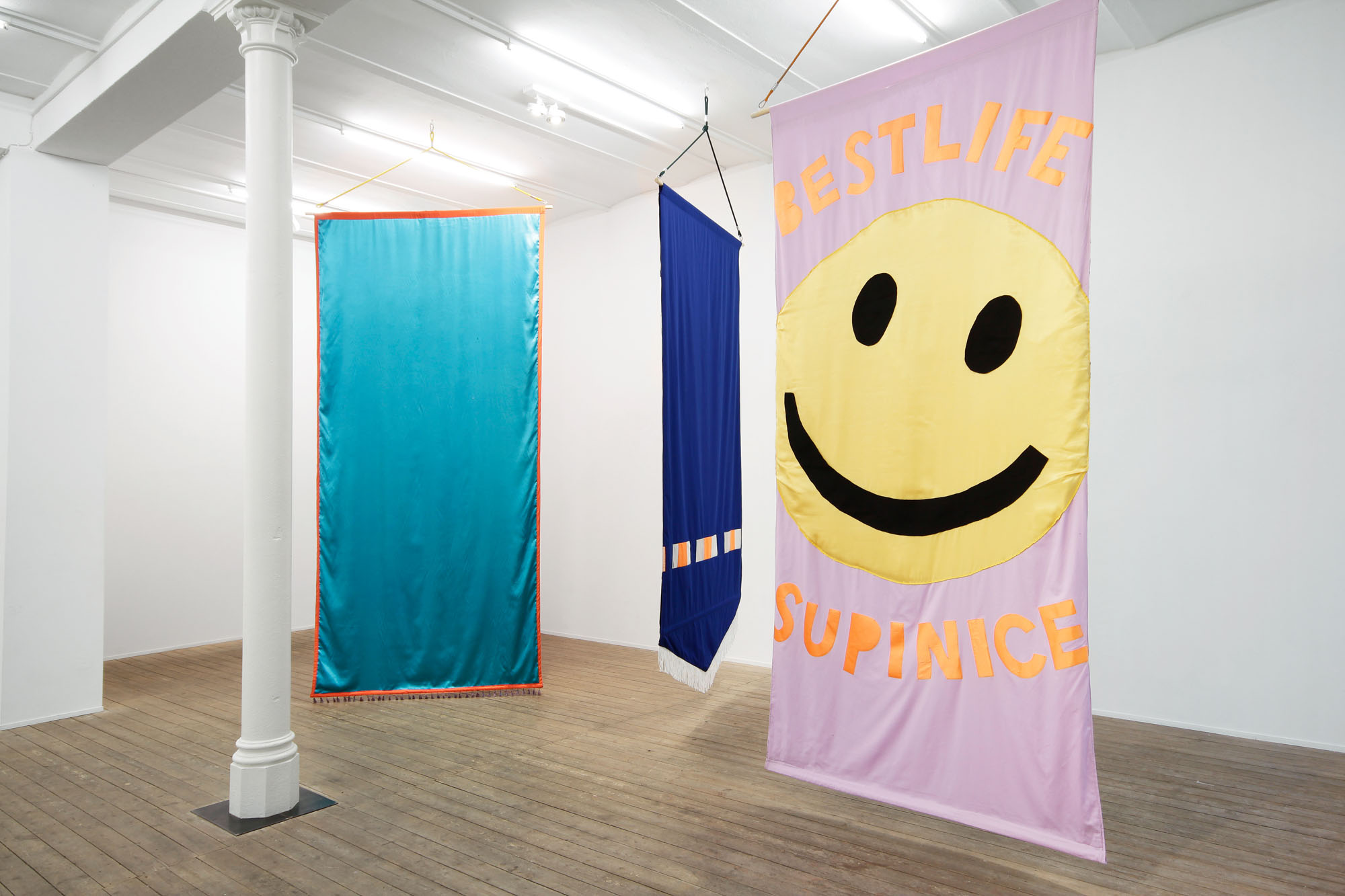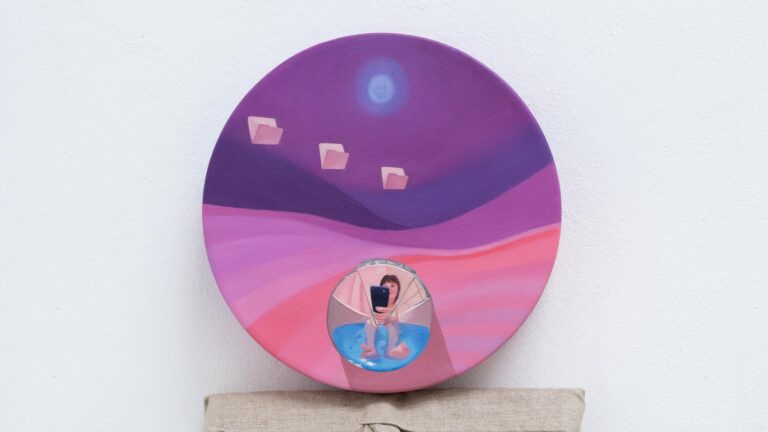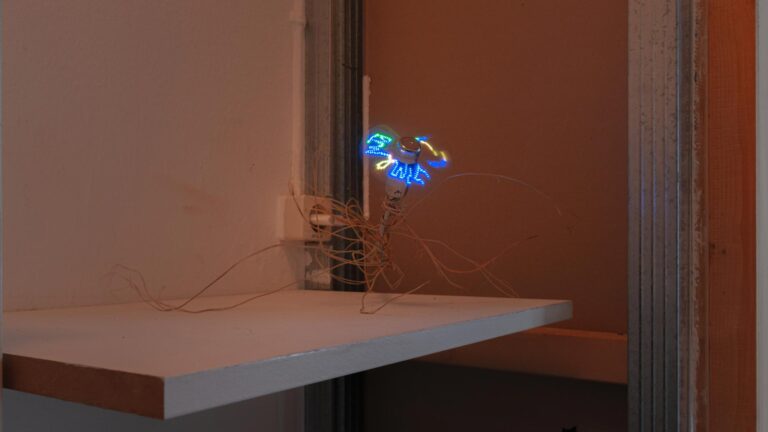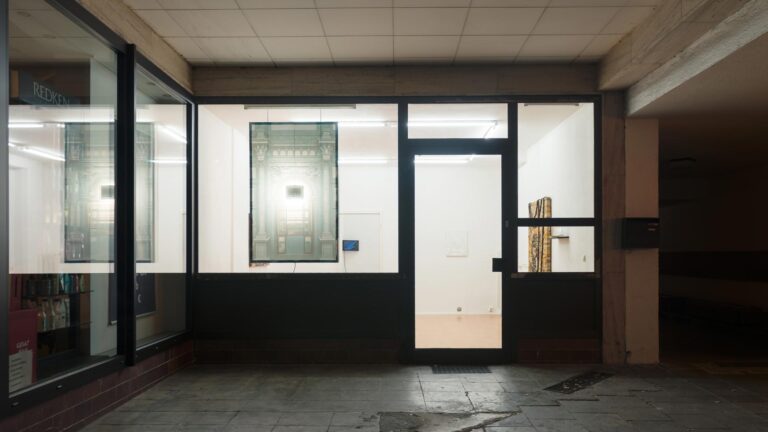Artists: Jil Lahr, Tintin Patrone, Christian Rothmaler, Supinice
Exhibition title: In his ideal, the center of the pit was to remain free of any shadows cast by the new buildings
Venue: Galerie Conradi, Hamburg, Germany
Date: April 4 – May 4, 2019
Photography: all images copyright and courtesy of the artist and Galerie Conradi, Hamburg/Brussels
Christian Rothmaler’s painting Get Cream in Neom looks like the outsized likeness of a hand. Casting no discernible shadow, the limb hovers at the center of the picture before a bright nonrepresentational background, a compositional template familiar to art historians from depictions of one of Christianity’s most mysterious relics: the Veil of Veronica. The peculiar sheen of the flesh tones may remind a beholder contemplating the hand of the otherworldly elegance of fourteenth-century frescoes in Italian churches—this hand, however, boasts seven fingers. The work’s title makes reference to the smart city Neom , a futuristic metropolis, running entirely on bioenergy and populated by a new and optimized subspecies of humanity, that is projected to rise in the desert of Saudi Arabia. Might the picture show the greeting of an emerging élite, the gesture with which its deity dispenses its blessing, the promulgation of a superior culture to come?
If the hand appears to float on a screen whose brightness setting is turned up too high, the effect is in part due to the luminous yellowish-white grid background. It is a nod to a technical imaging procedure that is emblematic of the objective and accurate recording, transmission, and production of reality. In the history of art, it has become a theme in its own right—see, for instance, Dürer’s Draftsman Drawing a Reclining Nude, which conveys the artist’s conviction that his work carried the authority of a scientific practice. Today’s users can rely on online tutorials to teach them all they need to know about 3D rendering software and the creation of animated characters and virtual spaces. Avatars can be assembled from individual perfectly shaped body parts; failed species filter back through the virtual biotopes of pluridimensional gaming universes into our realities.
A two-dimensional version—a mere outline—of a dinosaur comes into view under the title Guess Who’s Back. Jil Lahr lets the figure sprawl over almost the entire large-format canvas and eschews any suggestion of spatial depth. A sweeping green line activates the picture as a whole. Only upon closer examination do we realize that it is a retroactive simulation of a spontaneous remark: the line is not in fact an improvisation but a formal element that was digitally generated, tested, and only then transferred in halting brushstrokes onto the canvas. The meticulously balanced composition leaves no room for coincidence, expressiveness, or painterly gesture. Like Rothmaler’s hovering hand, the dinosaur does not cast a shadow. All in all, it resembles a pictogram rendered in isolation rather than a physical body convincingly integrated into, and interacting with, its surroundings.
The acknowledgment of such discontinuity implies a candor that unites the contributions to this exhibition. As a consumer and predator, the user operates in a space whose coordinates spanning an expanded reality grow increasingly diverse and complex even as they also become ever more constricted, being constantly adjusted to his behavior. Such personalized versions of reality remain valid only until their popularity fades and they cease to be profitable for users and providers alike. Scenarios of dilapidation and proliferating wastelands are part and parcel of these cultures and conceptions of reality (temple complexes, smart cities, shopping paradises, Second Life). Like a memento mori, animated cheeseburger wrapping papers drift weightlessly through Tintin Patrone’s video piece Yellow Dog Blues, the detritus of a long-gone future, grazing the ideally proportioned bodies of an ancient freestanding sculpture spinning forever around its own axis. In the otherwise sparsely outfitted simulation, collective memories of the parchment-like paper with its silky rustle make for a poetic touch, its pop-cultural perfection muting questions concerning originality and authorship as clinging to the insignificant problems of a past era. A Pikachu Pokémon comes into view. Where are we now? In a world we can already hold in hand wherever we go and will soon embed in our retinas?
The title of the exhibition alludes to the wishes of a famous Land artist who, in 1969, had an enormous hole in the ground excavated in an unused plot of land in Munich for a work he called Munich Depression. His vision was that, as the city would grow over the next several decades, planners would ensure that new buildings and their shadows would keep their distance from the crater. The ideal of a permanent artistic alteration of the world survives in a contemporary black-and-white photograph.
In his ideal, the center of the pit was to remain free of any shadows cast by the new buildings, 2019, exhibition view, Galerie Conradi, Hamburg
Left: Tintin Patrone, Right: Supinice, In his ideal, the center of the pit was to remain free of any shadows cast by the new buildings, 2019, exhibition view, Galerie Conradi, Hamburg
Tintin Patrone, Yellow Dog Blues, 2017, Video installation, HD Video, sound, dimensions variable
Supinice, In his ideal, the center of the pit was to remain free of any shadows cast by the new buildings, 2019, exhibition view, Galerie Conradi, Hamburg
Left: Jil Lahr, Right: Tintin Patrone, In his ideal, the center of the pit was to remain free of any shadows cast by the new buildings, 2019, exhibition view, Galerie Conradi, Hamburg
Jil Lahr, Guess Who’s Back, 2019, Acrylic on canvas, 230 x 195 cm
Left: Christian Rothmaler, Right: Tintin Patrone, In his ideal, the center of the pit was to remain free of any shadows cast by the new buildings, 2019, exhibition view, Galerie Conradi, Hamburg
Christian Rothmaler, Get Cream in Neom, 2018, Ink, acrylic, oil on canvas, 150 x 130 cm
Supinice, In his ideal, the center of the pit was to remain free of any shadows cast by the new buildings, 2019, exhibition view, Galerie Conradi, Hamburg
Supinice, In his ideal, the center of the pit was to remain free of any shadows cast by the new buildings, 2019, exhibition view, Galerie Conradi, Hamburg
Supinice, In his ideal, the center of the pit was to remain free of any shadows cast by the new buildings, 2019, exhibition view, Galerie Conradi, Hamburg
In his ideal, the center of the pit was to remain free of any shadows cast by the new buildings, 2019, exhibition view, Galerie Conradi, Hamburg
Left: Jil Lahr, Right: Supinice, In his ideal, the center of the pit was to remain free of any shadows cast by the new buildings, 2019, exhibition view, Galerie Conradi, Hamburg



















